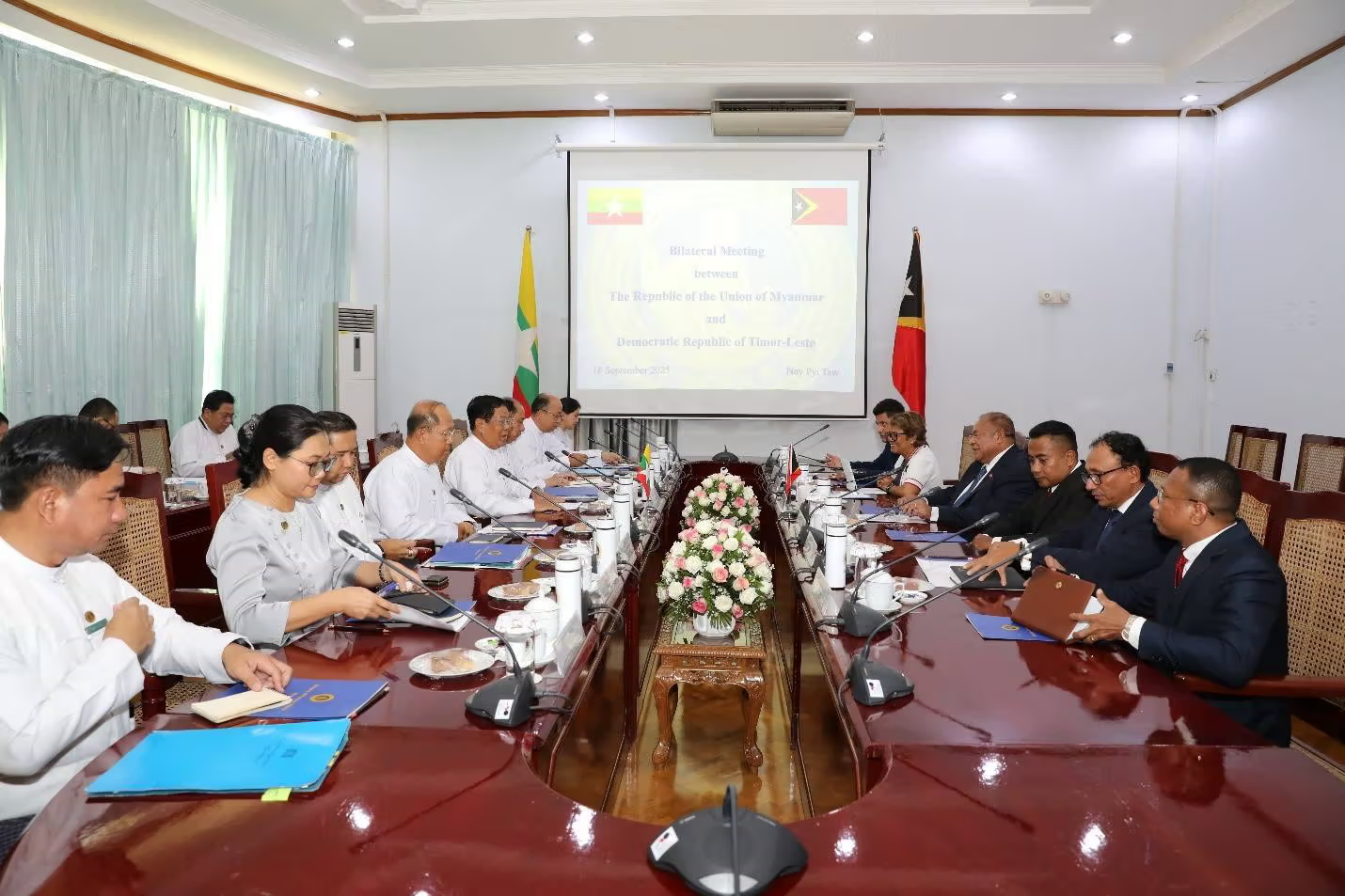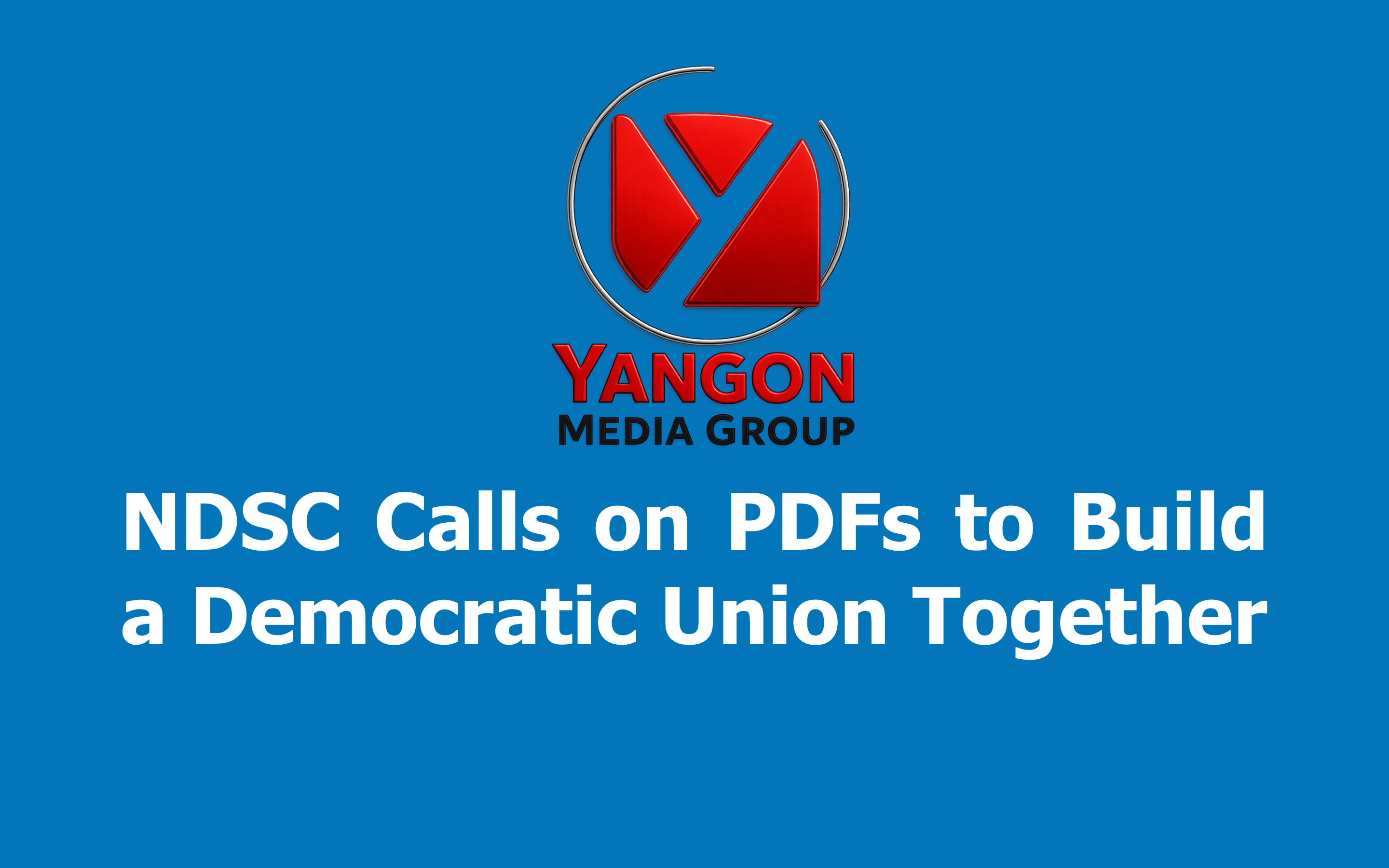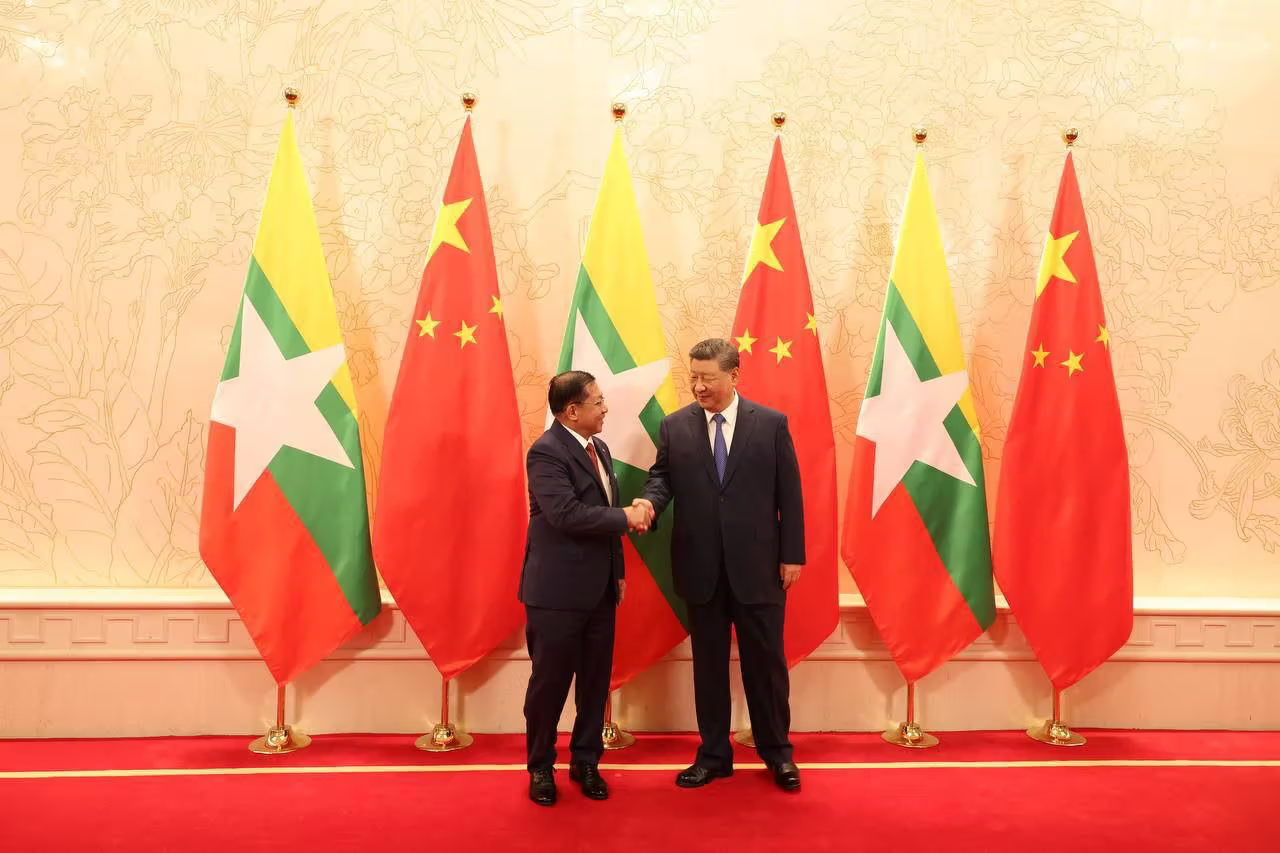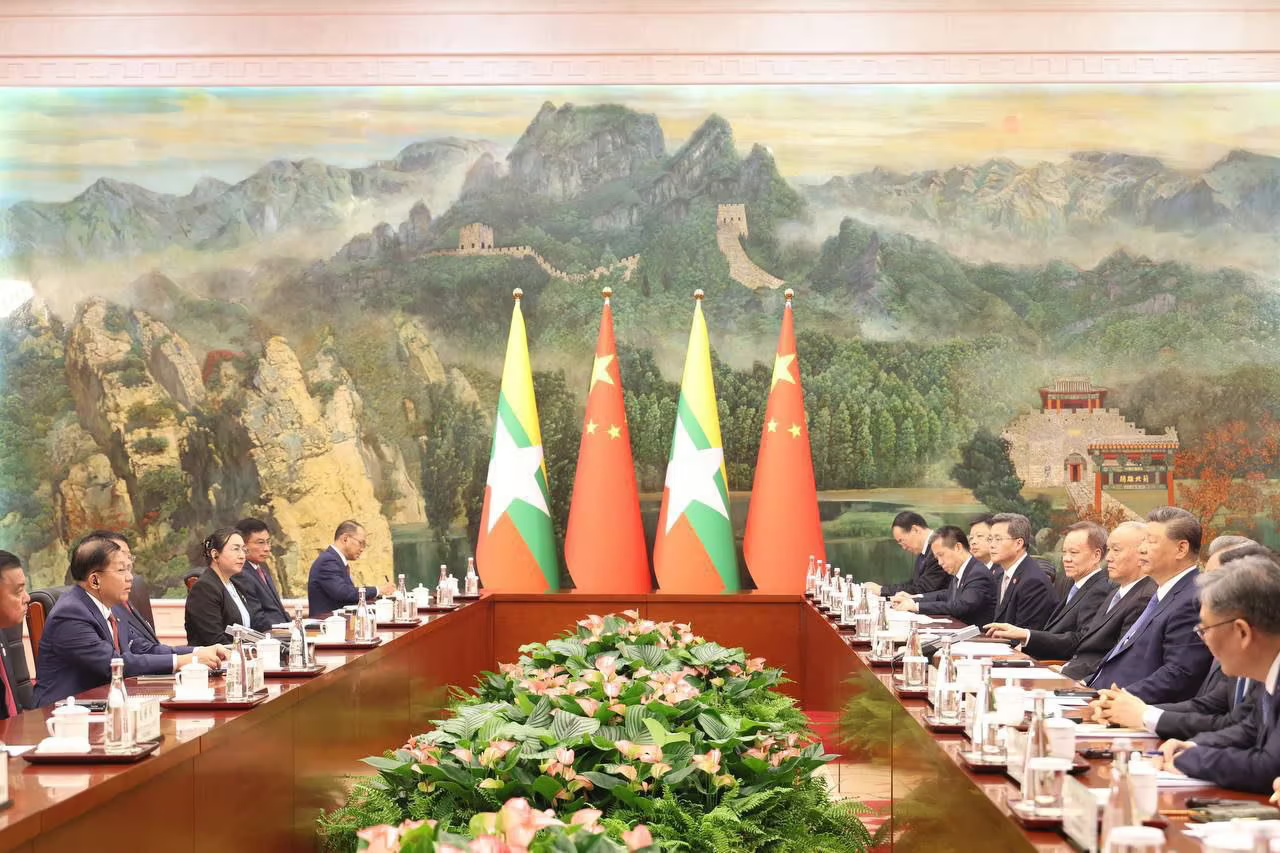
NAY PYI TAW, September 20, 2025 - A Myanmar delegation met with senior officials from the International Atomic Energy Agency (IAEA) on September 18 in Vienna, Austria, to discuss nuclear technology assistance programs for Myanmar.
According to a press release from the Myanmar Ministry of Foreign Affairs, the meeting took place during the IAEA's 69th General Conference. The Myanmar delegation, led by Ambassador U Min Thein, Permanent Representative of Myanmar to the UN and other international organizations in Vienna, and Dr. Theingi Maung Maung, Director-General of the Department of Atomic Energy under the Ministry of Science and Technology, met with a team led by Mr. Ge Deng, Director of the Division for Asia and the Pacific, Department of Technical Cooperation at the IAEA. The meeting was held at 11:30 AM on September 18, 2025, at the Vienna International Centre.

During the meeting, they discussed the progress of the technical assistance programs for Myanmar under the current 2024-2025 cycle.
In the afternoon of the same day, the Myanmar delegation also met with a team led by Ms. Liliya Dulinets, Head of the Nuclear Infrastructure Development Section, Department of Nuclear Energy at the IAEA. The discussion focused on obtaining regulatory and technical assistance for the development of Myanmar's nuclear energy infrastructure.
These meetings took place as Myanmar is undertaking initial activities to develop its nuclear energy sector.
#knl/ymg

NAY PYI TAW, Myanmar (September 19, 2025)-In a significant diplomatic gesture, Timor-Leste has pledged to the Myanmar government that it will not allow organizations opposing the government to open offices or conduct illegal protest activities within its borders. The promise was made by Mr. Bendito dos Santos Freitas, Timor-Leste's Minister of Foreign Affairs and Cooperation, during a working visit to Myanmar's capital.
The commitment was reportedly given to Myanmar’s Foreign Minister U Than Swe on September 18, according to an official press release from Myanmar’s Ministry of Foreign Affairs. The statement also noted that Minister Freitas extended an invitation for Myanmar to open an embassy in Dili, the capital of Timor-Leste.
During the meeting, the two foreign ministers emphasized their shared commitment to enhancing diplomatic relations based on the principles of the ASEAN Charter. They agreed to bolster ties while strictly adhering to the principle of non-interference in each other’s internal affairs.
Discussions also included potential agreements to boost cooperation, such as a visa exemption agreement for diplomatic and special passport holders and a separate visa exemption agreement to promote tourism between the two nations.
Minister Freitas and his delegation were in Myanmar for a working visit from September 17 to September 19, 2025.
#knl/ymg

Naypyidaw—September 12, 2025: The Myanmar Armed Forces (Tatmadaw) has announced it has fully regained control of military headquarters, outposts, wards, and villages in and around Bhamo town, which were temporarily held by KIA , AA and PDF terrorist insurgents.
Following the recapture, the Tatmadaw's information team stated that the insurgents suffered heavy casualties and are retreating in disarray towards the northeast of Bhamo and to Momauk, where their main forces are located.
According to the statement, military naval vessels carrying reinforcement troops proceeded to Bhamo in August 2025. Despite various difficulties and blockades by the insurgents—which damaged two push boats along the way—the vessels successfully arrived. From August 4, 2025, seven military columns were formed to advance.
One of the columns marched from the Bhamo University area northeast of the town and captured a camp at Nampha village before continuing its advance toward Bhamo.
Another column advanced from the north of Bhamo, securing the Naung Kho and Min Hla wards. Meanwhile, three columns from the east captured four local military headquarters, one outpost, and the airport area, which had been temporarily held by the insurgents.
The advancing columns then launched a two-pronged counter-offensive, while two additional columns intensified their counter-attacks in the Pin Hsin Kone, Nyaung Pin, Khun Tha, and Thar Si wards, including the area known locally as Kachin Su.
From December 4, 2024, to September 11, 2025, there were 16 major battles and 490 skirmishes with the terrorist insurgents. During these engagements, the Tatmadaw seized 163 bodies, 178 assorted weapons, and related equipment.
The statement also reported, based on separate news sources, that the combined insurgent groups suffered approximately 4,616 deaths and 4,983 injuries in these battles due to the military's valiant counter-attacks. The Tatmadaw, for its part, also lost some officers and soldiers who made the ultimate sacrifice for the state and the armed forces.
The statement noted that due to their heavy casualties, many insurgents are surrendering to the Tatmadaw's columns with their weapons, ammunition, and other related items.
The Tatmadaw's columns will continue to clear the remaining terrorist insurgents from within Bhamo town, the statement concluded.
#ymg/knl

NAY PYI TAW, Myanmar, September 8, 2025—In a detailed statement today, Myanmar’s National Defence and Security Council (NDSC) issued a fresh invitation to armed groups, specifically addressing those identified as People's Defence Forces (PDFs), urging them to return to the legal fold. The council's message centered on a core assertion: that all parties, including the government, military, political groups, and the PDFs themselves, share the common ambition of establishing a Union based on a genuine democratic and federal system.
The statement, released by the NDSC's Information Team, framed the invitation as a pragmatic and sincere step toward ending the nation’s prolonged conflict. It noted that armed individuals who have previously accepted the government’s invitation have already been successfully reunited with their families, demonstrating the sincerity of the peace offer.
The NDSC provided a historical context for its position, stating that the military’s 2021 actions were a necessary response to constitutional breaches during the 2020 general election. The council claimed that a peaceful resolution was sought but rejected, forcing the military to take action under Section 417 of the Constitution to prevent a "forcible seizure of state power."
According to the statement, the Committee Representing Pyidaungsu Hluttaw (CRPH) and the National Unity Government (NUG) were responsible for misleading the public and youth with "false hope," pushing them toward an armed, terrorist path. The council said these organizations of using PDFs as "proxies" for certain ethnic armed organizations (EAOs), sacrificing their lives for territorial expansion and violent acts.
The NDSC expressed hope that the hardships faced by armed groups, intensified by the government's cooperation with neighboring countries, would lead them to recognize the futility of armed struggle. The statement asserted that the path to a democratic and federal Union is through participation in the upcoming multi-party general election, a process it claims is designed to be free and fair.
The invitation stands as an open door for individuals and groups to return to the legal framework and contribute to national and regional interests. The statement concluded by assuring that the government and the military will welcome and accept those who wish to return, urging them to contact the nearest military bases or local authorities to begin dialogue and coordination.
#ymg/knl
The full statement is as follows:-
-Unofficial Translation-
8 August, 2025
Further Invitation for the Sake of the Union
As part of the invitation for the sake of the Union, armed groups, including those using the name "PDF," were invited to return to the legal fold with the hope of establishing a Union based on democracy and a federal system. Those who understood the State's genuine goodwill and returned, including those identifying as PDF, have now been handed back to their families.
The attempts to forcefully convene the parliament (Hluttaw) with the problematic election results, despite the sincere requests to address the voter list errors in the 2020 general election, constituted an attempt to seize state power by force under Section 417 of the Constitution. This was because the following requests were denied:
(a) The request to address and resolve the detected voter list errors and electoral fraud was rejected.
(b) The request to convene a special session of the Union Parliament (Pyidaungsu Hluttaw) to resolve the issue was rejected.
(c) The request for the State Government, the Union Parliament, and the Union Election Commission to find a solution was rejected.
(d) The request to convene a meeting of the National Defence and Security Council for discussion was submitted twice but not acted upon.
These actions not only revealed that there was electoral fraud and that it could not be openly disclosed, but also showed that the then-President himself was involved in the attempt to seize state power by force. This occurred at a time when he was being prosecuted for private offenses not related to his constitutional duties. Consequently, the acting President declared a state of emergency under the Constitution and transferred state power to the Commander-in-Chief of Defence Services.
The military, by exercising state power in accordance with the Constitution to investigate and expose electoral fraud and to hold a free and fair election, was misrepresented by domestic and international parties. They spread propaganda that the military was reversing democracy, portraying themselves as the elected government. They unlawfully formed the CRPH and NUG and pushed the public, especially the youth, toward an armed, terrorist path by giving them false hope. The CRPH and NUG formed groups using the name "PDF," and to acquire weapons and ammunition, they integrated them into certain EAOs. They used the PDFs as proxies to carry out terrorist acts and to illegally expand the territories of some EAOs, sacrificing the lives of the PDFs.
Now, due to the State Government's cooperation with neighboring countries, some terrorist EAOs are finding it difficult to sustain their operations, and those using the name "PDF" are facing greater hardship. It is time to truly see that the reversal of democracy is a result of the armed path.
The State Government, the public, the military, political parties, and even the PDFs all desire a Union based on a genuine democratic and federal system, sharing the same goal. The desire of the CRPH and NUG, who wear a democratic mask while craving state power, is to choose a terrorist, armed path to prevent the loss of their self-proclaimed status as the elected government. The delay in the democratic process is solely due to their disruption.
Armed groups, including those using the name "PDF," if they wish to work together with the State Government and the military for the benefit of the nation and their regions, with the hope of building the true and disciplined democratic and federal Union that everyone hopes for after the upcoming election, will be welcomed by the State Government and the military.
They are once again invited to contact the nearest military camps or local authorities, either individually or as a group, to coordinate and take action.
National Defence and Security Council
Information Team

Tianjin, August 30, 2025 – Chinese President Xi Jinping reaffirmed China’s support for Myanmar’s political structure and its efforts toward development and stability during a meeting with Myanmar’s Acting President and Chairman of the State Security and Peace Commission, Senior General Min Aung Hlaing. The discussions took place at the Tianjin Guesthouse on the evening of August 30, as part of Senior General Min Aung Hlaing’s working visit to the People’s Republic of China at the invitation of President Xi.
President Xi emphasized China’s consistent stance in supporting Myanmar’s progress and stability, expressing gratitude for Myanmar’s participation in the Shanghai Cooperation Organization (SCO) Summit 2025 and the 80th anniversary commemorations of China’s victory in the War of Resistance Against Japanese Aggression and the global anti-fascist war.
In response, Senior General Min Aung Hlaing highlighted Myanmar’s historical resistance against fascism, noting that the Myanmar Armed Forces commemorate March 27, 1945, as the start of their anti-fascist revolution, which is also marked as Armed Forces Day. He added that Myanmar celebrated the 80th anniversary of this milestone on March 27, 2025. He further underscored the significance of the SCO Summit in fostering international cooperation, noting Myanmar’s status as a dialogue partner since May 2023 and expressing hope for China’s continued support in Myanmar’s bid to become a full SCO member.

The leaders reviewed agreements reached during their May 2025 meeting in Moscow, focusing on countering foreign interference in Myanmar’s political affairs, enhancing the China-Myanmar strategic partnership, and promoting Myanmar’s stability. They also discussed Myanmar’s dignified participation in international and regional organizations.
Key topics included cooperation on Myanmar’s peace process, boosting trade, accelerating projects under the One Belt, One Road (OBOR) initiative and the China-Myanmar Economic Corridor (CMEC), sustainable use of natural resources, and China’s assistance following the Mandalay earthquake. Both leaders emphasized strengthening bilateral ties and supporting Myanmar’s upcoming multi-party democratic general elections scheduled for December 28, 2025, including preparations for international election observers.
President Xi reiterated China’s diplomatic support for Myanmar’s election preparations and its SCO membership aspirations, while both sides committed to deepening collaboration across various sectors. The discussions, described as open and constructive, underscored the mutual commitment to advancing bilateral relations and regional cooperation, according to a statement from Myanmar’s state media.
#ymg/knl

August 24, 2025- The Myanmar Government Information Team has warned that the TNLA and PDF terrorist groups who destroyed the world-famous historic Gokteik Viaduct with mines will face strong retaliation.
“This viaduct is a source of national pride and is widely used by the public. Its destruction is a cruel and ruthless act committed by TNLA and PDF terrorists. Regarding this, we will continue to carry out severe retaliatory actions,” Brigadier General Zaw Min Tun, head of the government’s Information Team, stated.
He added, “Based on current assessments, it seems highly unlikely that the viaduct can be repaired soon.”
On Sunday, August 24, at around 9:10 a.m., TNLA and PDF terrorists detonated mines on the northern side of the Gokteik Viaduct, which connects Nawnghkio and Kyaukme. The explosions damaged both the steel trusses and the brick supports of the structure.
The Gokteik Viaduct is a world-renowned historic landmark. Construction began in April 1899 and was completed on January 1, 1900. The 2,260-foot-long viaduct connects two mountain ridges and was built under contract by the Myanmar government of the time with American bridge construction companies from Pennsylvania and Maryland.
During World War II, the viaduct was twice destroyed by both Allied and Japanese forces. In May 1948, four months after Myanmar’s independence, Myanmar Railways began restoration work, which was completed in August 1951.
This latest attack is seen as a deliberate act by TNLA terrorists, who have been suffering defeats due to military offensives.
#ymg/knl

MINBU, Myanmar, Aug 20, 2025 — Myanmar has lost about 7% of its forest cover over the past 20 years, the country’s leader said on Tuesday, pledging new tree-planting efforts to slow the pace of deforestation.
Senior General Min Aung Hlaing, chairman of the State Security and Peace Commission, said forest coverage stood at 49% in 2005 but had declined to 42.19% in 2025.
“We are working to increase forest coverage back to around 50%,” he told a tree-planting event in Minbu, central Myanmar, on August 19, part of a nationwide reforestation campaign across 13 districts.
Myanmar has announced a five-year plan to expand tree planting through 2030, which it says will help curb environmental degradation and mitigate the impact of climate change.
Minbu was ranked among the world’s 15 hottest cities last year, highlighting the region’s vulnerability to extreme heat. At Tuesday’s event, officials and residents planted about 1,000 saplings of six species, including teak, tamarind and mahogany.
#ymg/knl